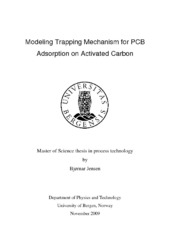Modeling trapping mechanism of PCB on activated carbon
Master thesis
Permanent lenke
https://hdl.handle.net/1956/3929Utgivelsesdato
2009-11-20Metadata
Vis full innførselSamlinger
Sammendrag
This thesis aims to investigate the trapping mechanism of polychlorinated biphenyls (PCB) on activated carbon. In the pursuit of this goal, molecular dynamics (MD) simulations were the method chosen. To be able to model a system of activated carbon, PCB and a triacylglycerol, individual molecular models had to be constructed for each of the components. The background for doing this work is that the levels of dioxin-like PCB, along with polychlorinated dibenzo-p-dioxin and dibenzofuran (PCDD/F) in fishmeal and fish oil produced for use in feed for salmon is above present European legislation levels in some regions. To reduce these levels, experiments have been carried out where these species are adsorbed on activated carbon. The adsorption process seems to be efficient for PCDD/F but less efficient for dioxin-like PCB. Two PCB molecules were chosen, namely 3,3',4,4'-Tetrachlorobiphenyl and 2,3',4,4',5-Pentachlorobiphenyl, PCB congener 77 and 118 respectively. In addition, a triacylglycerol in the form of triolein was chosen to represent the fish oil. These molecules were drawn up using Schrödinger's Maestro graphical user interface. A Brookhaven Protein Databank file was generated from this software, and this was used as a basis for a molecular structure and force field file for MDynaMix v5.1 (MD51), which was the MD software used in this thesis. The force field parameters characterizing these molecules were obtained from the force field known as OPLS - Optimized Potential for Liquid Simulations, for which the main author is Prof. William L. Jorgensen. Partial atomic charges were obtained from quantum chemical calculations using density functional theory, with B3LYP and STO-6-31+G** basis set, and the Solvation Model 6 in order to get the charges for water solvated molecules. Activated carbon (AC) is a graphitic material. Thus, graphite was used as the basis for the model of AC. A computer software utility was written during this thesis to generate a model of AC. This was necessary in order to build the model since it contains no less than 31232 carbon atoms. Similarly, in order to assign partial atomic charges to the individual atoms in this model a new software tool was written to do the job. The models for the PCB molecules were validated with respect to their molar enthalpies of vaporization. However, the models for AC and triolein were not validated due to the time constraint. From the validations of PCB models, it was found that the model for PCB 77 gives II good results for the molar enthalpy of vaporization; however, a slight deviation from the experimental values is observed. PCB congener 118 is able to replicate the experimental values for the molar enthalpy of vaporization. Nevertheless, the conclusion about these model is that the phenyl-phenyl ring torsion angles does not have the correct parameters. Consequently, even though the models can replicate thermodynamic properties, they need new torsion angle parameters for the phenyl-phenyl ring torsion angle in order to replicate the correct molecular structures. Furthermore, the individual components were merged into a large simulation, using a modified version of the MD51, which allowed an external force to rapidly move the liquid phase down on the AC model. This external force was subsequently scaled down over time. Again, due to the short time available for this thesis, the main simulation is still an immature system, with...
Utgiver
The University of BergenOpphavsrett
The authorCopyright the author. All rights reserved
